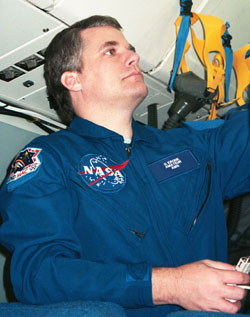 |
Gary W. Kronk (born 1956) is an American amateur astronomer and writer.
 |
Gary W. Kronk (born 1956) is an American amateur astronomer and writer.
Kronk was born in Granite City, Illinois, United States, on March 23, 1956. He developed an interest in space at an early age, during the time of the first crewed space flights of project Mercury; however, it was Mariner 4's close-up images of Mars that appeared on television the night of July 14, 1965 that focused his interest to astronomy. This interest was focused even more by Comet Kohoutek (C/1973 E1). Kronk first observed this comet on November 30, 1973, when he was a senior in high school. This observation provided the encouragement to research and write a paper about this comet and other great comets of the past for school. The teacher liked the paper so much, she submitted it to the local paper. He has been observing, researching, and writing about comets ever since. [1]
Kronk received a bachelor of science degree in journalism from Southern Illinois University Edwardsville in 1981. He was then just shy of spending seven years in college as he struggled to find a major. In the end, he had a minor in English and extended studies in mathematics, physics, and psychology. [2]
Kronk is known as a comet observer, researcher, and writer. His latest book project is Cometography, which is a six-volume series being published by Cambridge University Press. [3] [4] His knowledge of the history of comets has led to the linking of several comets to older apparitions. This includes linking periodic comet 109P/Swift-Tuttle to Chinese comets seen in 69 BC and AD 188, [5] [6] which helped confirm that the comet's motion was not greatly influenced by nongravitational effects, and linking periodic comet 104P/Kowal to a comet reported by the Reverend Leo Boethin (Philippines) in 1973, which helped confirm that its motion was greatly influenced by nongravitational effects. [7]
Kronk's comet research is also strongly aligned to meteor shower research, because of the relationship between the two fields. He wrote the book Meteor Showers in 1988 and his expertise in the field drew an invitation to become part of the historic NASA/US Air Force Leonid MAC 99 which studied a meteor storm from the Leonid meteor shower while flying over the Mediterranean Sea. [8]
Charles P. Olivier Award, American Meteor Society, 1999.
The asteroid 48300 Kronk was named in his honor.
Comets: A Descriptive Catalog, Enslow Publishers, Inc. (1984)
Meteor Showers, Enslow Publishers, Inc. (1988)
Cometography, volume 1, Cambridge University Press (1999)
Cometography, volume 2, Cambridge University Press (2004)
Cometography, volume 3, Cambridge University Press (2007)
Cometography, volume 4, Cambridge University Press (2008)
Cometography, volume 5, Cambridge University Press (2010)
Cometography, volume 6, Cambridge University Press (2017)
Meteor Showers, 2nd edition, Springer. (2013)
Lewis Swift: Celebrated Comet Hunter and the People's Astronomer, Springer. (2017)
https://web.archive.org/web/20230726005021/https://meteorshowersonline.com/

A comet is an icy, small Solar System body that warms and begins to release gases when passing close to the Sun, a process called outgassing. This produces an extended, gravitationally unbound atmosphere or coma surrounding the nucleus, and sometimes a tail of gas and dust gas blown out from the coma. These phenomena are due to the effects of solar radiation and the outstreaming solar wind plasma acting upon the nucleus of the comet. Comet nuclei range from a few hundred meters to tens of kilometers across and are composed of loose collections of ice, dust, and small rocky particles. The coma may be up to 15 times Earth's diameter, while the tail may stretch beyond one astronomical unit. If sufficiently close and bright, a comet may be seen from Earth without the aid of a telescope and can subtend an arc of up to 30° across the sky. Comets have been observed and recorded since ancient times by many cultures and religions.

The Leonids are a prolific meteor shower associated with the comet Tempel–Tuttle, which are also known for their spectacular meteor storms that occur about every 33 years. The Leonids get their name from the location of their radiant in the constellation Leo: the meteors appear to radiate from that point in the sky. Their proper Greek name should be Leontids, but the word was initially constructed as a Greek/Latin hybrid and it has been used since. The meteor shower peak should be on 17 November, but any outburst is likely to be from the 1733 meteoroid stream.

A meteor shower is a celestial event in which a number of meteors are observed to radiate, or originate, from one point in the night sky. These meteors are caused by streams of cosmic debris called meteoroids entering Earth's atmosphere at extremely high speeds on parallel trajectories. Most meteors are smaller than a grain of sand, so almost all of them disintegrate and never hit the Earth's surface. Very intense or unusual meteor showers are known as meteor outbursts and meteor storms, which produce at least 1,000 meteors an hour, most notably from the Leonids. The Meteor Data Centre lists over 900 suspected meteor showers of which about 100 are well established. Several organizations point to viewing opportunities on the Internet. NASA maintains a daily map of active meteor showers.

The Perseids are a prolific meteor shower associated with the comet Swift–Tuttle. The meteors are called the Perseids because the point from which they appear to hail lies in the constellation Perseus.

Comet Encke, or Encke's Comet, is a periodic comet that completes an orbit of the Sun once every 3.3 years. Encke was first recorded by Pierre Méchain on 17 January 1786, but it was not recognized as a periodic comet until 1819 when its orbit was computed by Johann Franz Encke. Like Halley's Comet, it is unusual in its being named after the calculator of its orbit rather than its discoverer. Like most comets, it has a very low albedo, reflecting only 4.6% of the light its nucleus receives, although comets generate a large coma and tail that can make them much more visible during their perihelion. The diameter of the nucleus of Encke's Comet is 4.8 km.
Horace Parnell Tuttle was an American astronomer, an American Civil War veteran and brother of astronomer Charles Wesley Tuttle.

55P/Tempel–Tuttle is a periodic comet with an orbital period of 33 years. It fits the classical definition of a Halley-type comet with a period of between 20 and 200 years. It was independently discovered by Wilhelm Tempel on December 19, 1865, and by Horace Parnell Tuttle on January 6, 1866.
Alphonse Louis Nicolas Borrelly was a French astronomer.
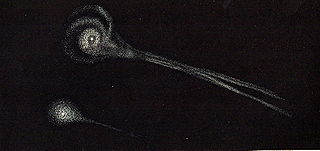
Biela's Comet or Comet Biela was a periodic Jupiter-family comet first recorded in 1772 by Montaigne and Messier and finally identified as periodic in 1826 by Wilhelm von Biela. It was subsequently observed to split in two and has not been seen since 1852. As a result, it is currently considered to have been destroyed, although remnants appeared to have survived for some time as a meteor shower, the Andromedids.
Comet Boethin was a periodic Jupiter-family comet discovered in 1975 by Leo Boethin. It appeared again in January 1986 as expected. Although the comet was next expected at perihelion in April 1997, no observations were reported, and the comet is thought to have disintegrated. It has not been observed since March 1986. The comet might have come to perihelion in late July 2020, but the uncertainty in the comet's position is hundreds of millions of km. The old orbit would have the comet next coming to perihelion around November 2031.
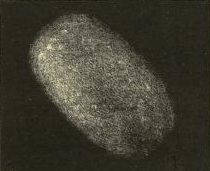
5D/Brorsen was a periodic Jupiter-family comet discovered on February 26, 1846, by Danish astronomer Theodor Brorsen. The perihelion of 5D/Brorsen was February 25, just a day before its discovery, and it passed closest to Earth on March 27, at a distance of 0.52 AU. As a result of this close encounter to Earth the comet's coma diameter increased. Johann Friedrich Julius Schmidt estimated it as 3 to 4 arcminutes across on March 9, and 8 to 10 arcminutes across on the 22nd of that same month. On April 22, it was about 20 degrees from the north celestial pole. By the end of this first apparition the orbital period was calculated as 5.5 years. It was discovered that a close approach to Jupiter in 1842 put it in its discovery orbit.

8P/Tuttle is a periodic comet with a 13.6-year orbit. It fits the classical definition of a Jupiter-family comet with an orbital period of less than 20 years, but does not fit the modern definition of. Its last perihelion passage was 27 August 2021 when it had a solar elongation of 26 degrees at approximately apparent magnitude 9. Two weeks later, on September 12, 2021, it was about 1.8 AU (270 million km) from Earth which is about as far from Earth as the comet can get when the comet is near perihelion.

53P/Van Biesbroeck is a periodic comet 7 km in diameter. Its current orbital period is 12.53 years.
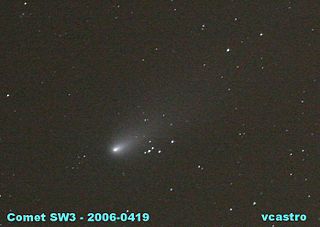
73P/Schwassmann–Wachmann, also known as Schwassmann–Wachmann 3 or SW3 for short, is a periodic comet that has a 5.4 year orbital period and that has been actively disintegrating since 1995. When it came to perihelion in March 2017, fragment 73P-BT was separating from the main fragment 73P-C. Fragments 73P-BU and 73P-BV were detected in July 2022. The main comet came to perihelion on 25 August 2022, when the comet was 0.97 AU from the Sun and 1 AU from Earth. It will be less than 80 degrees from the Sun from 25 May 2022 until August 2023. On 3 April 2025 it will make a modest approach of 0.3 AU to Jupiter. 73P will next come to perihelion on 23 December 2027 when it will be 0.92 AU from the Sun and on the far side of the Sun 1.9 AU from Earth.

13P/Olbers is a periodic comet with an orbital period of 69 years. It fits the classical definition of a Halley-type comet with.

A lost comet is one which was not detected during its most recent perihelion passage. This generally happens when data is insufficient to reliably calculate the comet's location or if the solar elongation is unfavorable near perihelion passage. The D/ designation is used for a periodic comet that no longer exists or is deemed to have disappeared.
X/1872 X1, occasionally referred to as "Pogson's Comet", was a probable cometary astronomical object seen from Madras on December 3 and 4, 1872, by astronomer N. R. Pogson.
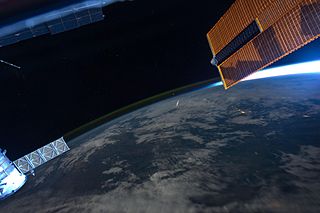
Comet Swift–Tuttle is a large periodic comet with a 1995 (osculating) orbital period of 133 years that is in a 1:11 orbital resonance with Jupiter. It fits the classical definition of a Halley-type comet, which has an orbital period between 20 and 200 years. The comet was independently discovered by Lewis Swift on July 16, 1862 and by Horace Parnell Tuttle on July 19, 1862.

Comets have been observed for over 2,000 years. During that time, several different systems have been used to assign names to each comet, and as a result many comets have more than one name.
{{cite web}}: CS1 maint: archived copy as title (link)Gary W. Kronk in libraries ( WorldCat catalog)